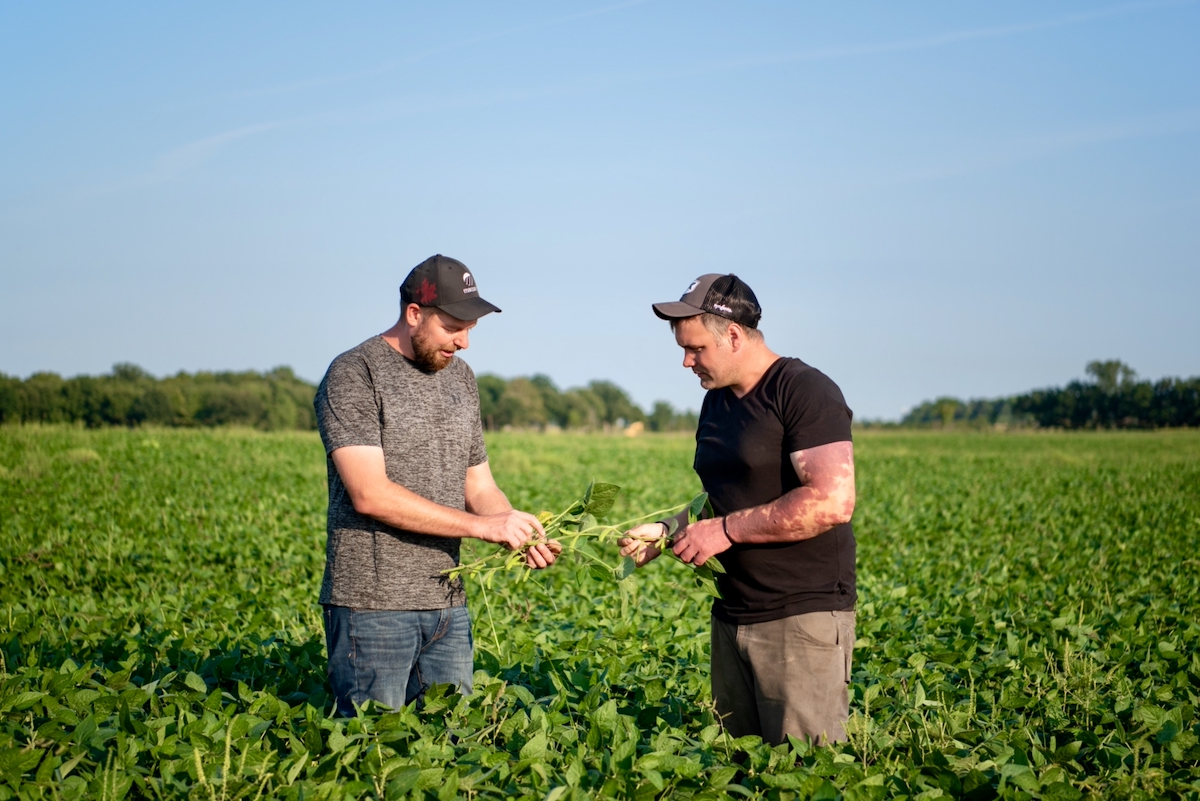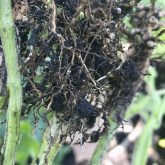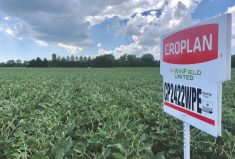The arrival of a new herbicide-resistant technology is often greeted as an opportunity for growers and the industry. That isn’t really new. Roughly 30 years ago, Group 2 herbicides solved the problem of atrazine resistance, then LibertyLink and Roundup Ready technologies enabled growers to push beyond Group 2 resistance.
Now that Xtend and Enlist systems are rolling out, the issues surrounding glyphosate resistance will fade from memory, right?
Well, there are some in the agronomic industry — retailers, dealers and advisors — who question the idea that more technologies translate into greater simplicity or convenience. Consider the introduction of Xtend soybeans: in 2015, Monsanto’s exhibit at Canada’s Outdoor Farm Show went into great detail about the use of Xtendi-Max (and Engenia the following year). There were specific conditions governing applications, including wind and ground speed, water volumes and rates, proximity to non-Xtend crops, and even protocols for triple-rinsing spray tanks to ensure crop safety in subsequent applications.
Read Also

Ontario farmers partner for success
Ontario business partners, Matt Bergman and DJ Wassenaar, have been farming together for 10 years. Their focus on integrating unconventional…
Both technologies are undergoing their growing pains and some producers are learning the hard lessons about the differences between newer dicamba formulations and those with 2,4-D. Anecdotal reports tell of accidental applications of 2,4-D on Xtend soybeans and vice versa.
For Wayne Barton, new technology can make things easier for growers, with one key proviso. They’re only easier in the beginning.
“But in the background, farming has always been complicated and growers are balancing a lot of management decisions, a lot of factors, so it’s never easy,” says Barton, manager of research and commercial development for BASF. “When you have good technology, it can make it a little less complicated, a little bit simpler. Canadian growers have always known that: they’re innovative and have always been willing to learn.”

The private sector tries to help by simplifying things as much as possible, with education, training, labelling and even packaging. Yet with something new, there’s always the potential for added complexity.
Barton believes growers see Xtend and Enlist technologies as another pair of tools, in much the same way as they viewed Roundup Ready technology. What the previous generation of herbicide-resistant tools has taught them is the need to guard the technologies’ sustainability. He remembers the advent of both LibertyLink and Roundup Ready systems, and discussion of whether a single mode-of-action herbicide in the same crop would be sustainable.
“In fact, the technologies have been very resilient, and maybe more resilient than we expected at the beginning,” says Barton, adding that he believes Canadian growers were aware and attentive to the potential for resistance. “As the reliance on glyphosate and the utility of Liberty increased, they were paying more attention to it because they knew how important those technologies were.”
Originally, there was also the opportunity to watch what was unfolding in the U.S., where those technologies were first adopted. It was obvious that they worked but also that the risks were real. That particular situation — with glyphosate resistance — may have played a significant part in that resiliency in Canada, says Barton. It may be why so many have embraced Xtend soybeans or Enlist corn and soybeans. At the same time, they want to know how to use Xtendi-Max or Engenia efficiently and effectively, so they can continue using both.
Value-added picture
In a straight three-crop rotation setting, Xtend and Enlist technologies may be incorporated with less of an issue, but is the same true when premium or contracted crops enter the picture? According to Anita Speers, the newer technologies can come with a steeper-than-expected learning curve in some cropping practices. Growers trying to push a spray application beyond the label-rate stipulation of the third trifoliate can find themselves in trouble with crop damage from drift or volatilization.
“The task of managing different technologies has, to some extent, complicated matters more than simplified them,” says Speers, crop input representative with Lakeside Grain & Feed. “With the introduction of technologies such as the Xtend and Enlist systems, it’s helped to simplify the initial decisions for growers. But as we get further into using the Xtend production system, other problems have started to appear.”
As for the lessons learned during the 20-plus year histories of Roundup Ready and LibertyLink, Speers cites the 20/20 quality of hindsight, noting that stewardship directives with glyphosate in particular might have helped back then. But then the industry had never worked with a molecule like glyphosate.
“LibertyLink and Roundup Ready technologies gave producers brand new tools to use in their production systems,” says Speers. “Xtend and Enlist are using blends of previously used products, but even with the new and improved formulation of these products, the application information has somewhat fallen on deaf ears.”
Speers notes that in comparing dicamba’s earlier formulation, Banvel, to the current products — either Engenia or Xtendi-Max — farmers sometimes only hear that the new formulations have lower volatilization. What they don’t hear is that the newer products are less forgiving, particularly the volatilization potential under less-than-ideal conditions.
“Efforts cannot let up on the use of this technology and how we as an industry can keep it around for future use,” adds Speers, noting the current technologies make use of only three chemical groups. “I look at the growers I work with who use these three groups but also choose to include products from Groups 2, 5, 14 and 15. They know that if they continually use the same mode of action, resistance is bound to form and they do not want to lose the use of those chemical families.”
There are two messages that Speers believes need to be shared among growers. One echoes the work of Dr. Peter Sikkema from the University of Guelph’s Ridgetown Campus that there are still very good options to combat glyphosate-resistant weeds. The second is a suggestion that Speers puts forth, for a Grower Pesticide License program, a day-long certification course to help growers understand the use of dicamba, 2,4-D and Liberty. Those found to be applying any of the technologies outside of the prescribed label usage would have their license revoked.
It’s a harsh measure but one that Speers believes has merit, harkening back to the Canadian Food Inspection Agency’s (CFIA) initiative during the early 2000s that would ban sales of Bt corn seed to those not planting a non-Bt refuge.
What’s next?
It also serves as a means of ensuring sustainability within production agriculture, whether that’s framed within the context of food security, longevity of the technology or food traceability. Barton acknowledges that traceability isn’t always a welcome subject, often because it’s misconstrued as a consumer demand instead of a farmer benefit.
In 1997, as Roundup Ready soybeans were launched in Canada, one certified crop advisor suggested that it might be necessary for growers to sign off on fields to be sprayed with glyphosate. The technology was so new back then that the liability surrounding its use warranted consideration for measures to protect those who used it or applied herbicides within it.
Within that sustainability sphere, will similar measures be needed to ensure the proper applications for Xtend or Enlist crops today?
Barton believes there may be a need for some sort of check-and-balance, but he believes it has more to do with growers embracing technology than calls for traceability. That demand has been around for years but the technology around digital farming could enable its progression. Barton knows a grower who has a five-year history of their fields stored on their cell phone. The technology is there, it’s available and it’s going to be used.
“It’s going to continue to be used, not because we have to but because growers are going to want to do it, and because consumers will be willing to pay for it,” he says. “Maybe that’s going to be the table stakes to be in certain markets where they’re willing to pay.”
The industry is building in that form of digital referencing, better known as blockchain technology. It’s an accountability platform that many in the industry say will ultimately benefit farmers with higher profitability, but even now it’s a system that is only in its infancy.
Information is increasingly vital
Another undervalued aspect of these transgenic technologies that’s driving change is in the exchange of information, some of it pertaining to the use of the technologies, some relating to production agriculture in general. Speers notes that connecting with farmers on the use of these and other systems is one of the better parts of her job.
“In the past year and a half, we’ve hosted a dicamba application workshop where we partnered with BASF to give our growers a presentation on how to apply dicamba, and the difference between Engenia and Banvel formulations,” says Speers.
For Barton, access to resources is invaluable, especially considering the increased complexity of farming, the larger operations and the availability of quality information. As more growers continue to broaden their use of trait technologies, trustworthy insight and advice become invaluable.
“It’s an innovative and more competitive industry, and by that, I mean the dealer, the retailer, the seed and the chemical industry,” says Barton, noting that farmers are willing to invest in innovation and information. “We’re in the business of helping growers with the use of technology. It’s so competitive, if one company is off base from a stewardship perspective or is leaving a void in the market, others will quickly find a solution to balance the message.”
And farmers aren’t operating in a vacuum. They need to realize (and most have) that they’re part of a food chain system, where consumers are becoming increasingly vocal. Speers acknowledges that retailers, dealers and company representatives are doing their part, but believes there are some “weak links” in the food chain. Consumers may be demanding and not understand how Xtend or Enlist systems work, but that doesn’t mean they should be excluded from discussions.
“Sadly, the general public seems to trust Google as their information provider,” says Speers. “We need to improve how the general consumer views agriculture and be open to answering their questions, not dismissing the consumer as lazy or uneducated.”
This article originally appeared in the October 2019 issue of the Soybean Guide.
















